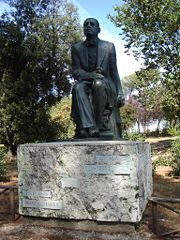
Ahmed Shawki Museum
Encyclopedia

Museum
A museum is an institution that cares for a collection of artifacts and other objects of scientific, artistic, cultural, or historical importance and makes them available for public viewing through exhibits that may be permanent or temporary. Most large museums are located in major cities...
is located on the Nile Corniche, Giza part of Cairo
Cairo
Cairo , is the capital of Egypt and the largest city in the Arab world and Africa, and the 16th largest metropolitan area in the world. Nicknamed "The City of a Thousand Minarets" for its preponderance of Islamic architecture, Cairo has long been a centre of the region's political and cultural life...
, Egypt
Egypt
Egypt , officially the Arab Republic of Egypt, Arabic: , is a country mainly in North Africa, with the Sinai Peninsula forming a land bridge in Southwest Asia. Egypt is thus a transcontinental country, and a major power in Africa, the Mediterranean Basin, the Middle East and the Muslim world...
.
The museum is named after and dedicated to the poet and dramatist Ahmed Shawki (1869–1932), who used to live in ‘Karmet Ibn Hani’ or Ibn Hani’s Vineyardin كرمة ابن هانىء at Al-Matariyyah
Al-Matariyyah
Al-Matariyyah, Mataria or El Matariya is a district in the northern region of Greater Cairo, east of the Nile, in Egypt. The district is unrelated to the El Matareya coastal region in the Dakahlia Governorate...
area near the palace of the Khedive Abbas II at Saray El-Qobba until he was exiled. After returning to Egypt, he built a new house at Giza which he named the new Karmet Ibn Hani. The Giza house later on became Ahmed Shawki Museum. It was first acquired in 1914 and named ‘Karmet Ibn Hani’ or Ibn Hani’s Vineyard, after the poet Abu Nawwas. It takes the form of a lavish white palace surrounded by a green garden and officially opened on 17 June 1977.
The museum is noted for its bronze
Bronze sculpture
Bronze is the most popular metal for cast metal sculptures; a cast bronze sculpture is often called simply a "bronze".Common bronze alloys have the unusual and desirable property of expanding slightly just before they set, thus filling the finest details of a mold. Then, as the bronze cools, it...
statues. In the garden, there is a large statue of the poet, created by late Egyptian sculptor Gamal El Seguini. The statue was erected in a ceremony marking the 50th anniversary of the poet's death. It is however a replica, as the Italian Government ordered in 1962 that it be erected in the Bourgese Park, Rome
Rome
Rome is the capital of Italy and the country's largest and most populated city and comune, with over 2.7 million residents in . The city is located in the central-western portion of the Italian Peninsula, on the Tiber River within the Lazio region of Italy.Rome's history spans two and a half...
, alongside the statues of other world artistic figures. The ceremony was attended by the Egyptian and Italian Ministers of Culture, the Mayor of Rome, and many Arab artists, poets, and writers.
There are also bronze statues of torch-bearing cherubic messengers. The torches represent enlightenment.
Interior
On the ground floor is the Mohammed Abdel WahabMohammed Abdel Wahab
Mohammed Abdel Wahab , also transliterated Mohammed Abd el-Wahaab was a prominent 20th-century Arab Egyptian singer and composer...
Suite which comprises Ahmed shawki's library with 332 books and valuable draft manuscripts of poems hand-written by the poet on plain paper. There is also work related to singer and composer Mohammed Abdel Wahhab who was introduced to art by Shawqi and once practised and performed for Ahmed Shawki. There is a high-quality audio library in the museum containing such recordings.
The upper floor comprises his bedroom with his grand bed with high brass poles, a dressing table, photographs and then the room of Mrs. Khadija Hanem Shaheen, the poet's wife noted for its old-style elegant furniture and brass effigies of cherubim. There is a room on the upper floor containing more than 713 manuscripts and drafts of the poet's work and also a collection of oil paintings, antiques and photographs related to Shawki's life. Next to the study, there is a room presenting his accolades, ranging from gifts and certificates, to insignia
Insignia
Insignia or insigne pl -nia or -nias : a symbol or token of personal power, status or office, or of an official body of government or jurisdiction...
s and badges of honor including an encased gala uniform.

